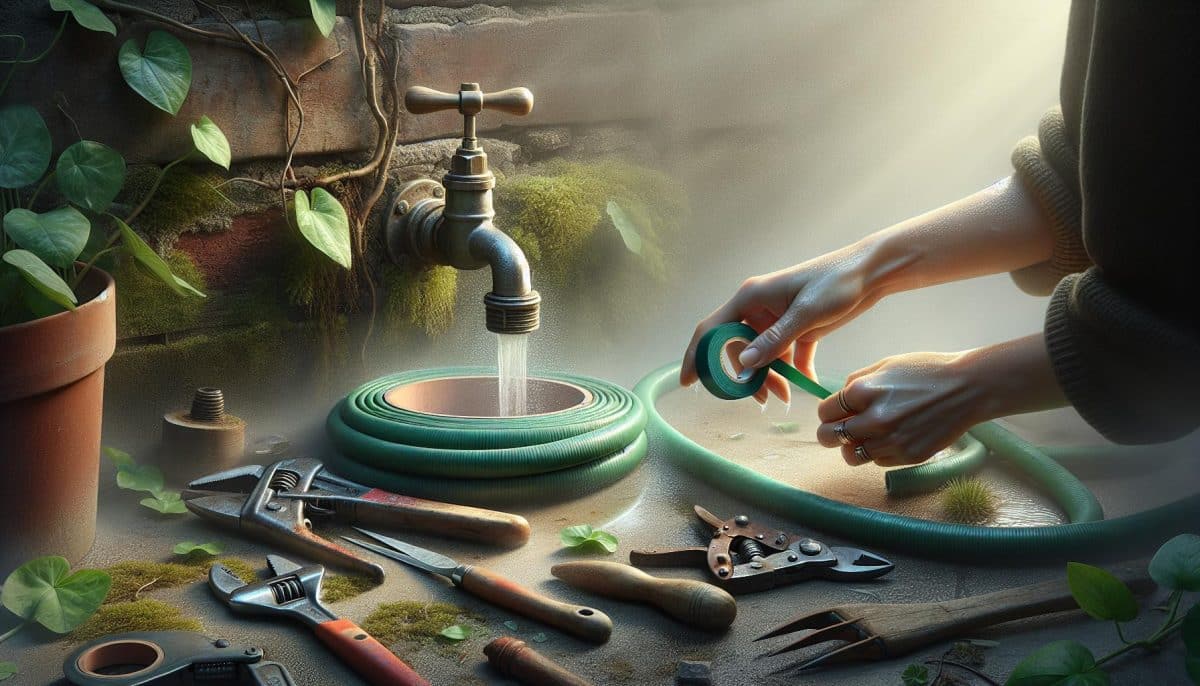
Struggling with a leaky garden hose? You’re not alone. Many garden enthusiasts face this common issue, but there’s a simple, effective solution that might just be sitting in your toolbox: plumber’s tape. Also known as Teflon tape, this nifty polymer is a go-to for creating watertight seals in a jiffy.
In the world of DIY fixes, knowing how to properly use plumber’s tape on your garden hose can save you time, water, and frustration. It’s not just about stopping leaks; it’s about ensuring your garden watering system works efficiently without the hassle of unexpected drips and water waste. Let’s jump into how you can master this simple yet crucial skill.
Preparation for Applying Plumbers Tape on Garden Hose
Before you get started with applying plumber’s tape to your garden hose, ensuring you’re well-prepared is crucial. This means gathering all necessary materials and properly cleaning the garden hose threads. By following these steps, you’ll be setting yourself up for a successful and leak-free connection.
Gathering the Necessary Materials
To apply plumber’s tape correctly, you’ll need a few basic materials. Firstly, make sure you have a roll of Teflon tape. While commonly referred to as plumber’s tape, its technical name is polytetrafluoroethylene (PTFE) tape. Remember, not all Teflon tapes are created equal. For garden hoses, you’ll typically use the standard white Teflon tape, which is readily available at hardware stores.
- Teflon (PTFE) tape: A must-have to ensure a watertight seal.
- Clean Cloth: To wipe down the threads before application.
- Scissors: Though not always necessary, they can be handy for cutting the tape cleanly.
Having these materials on hand before you begin will streamline the process, ensuring you’re not searching for tools mid-task.
Cleaning the Garden Hose Threads
Before applying the Teflon tape, it’s imperative to clean the threads of your garden hose. This step is often overlooked, but it’s crucial for ensuring the tape adheres properly and creates a seal that’s both tight and leak-free.
Here’s how to clean the threads effectively:
- Disconnect the garden hose to access the threads.
- Use a clean cloth to wipe away any dirt, debris, or rust from the threads. For stubborn grime, a small wire brush can be gently used to dislodge it.
- Rinse the threads briefly with water to remove any loosened dirt.
- Dry the threads thoroughly with another clean cloth. Any moisture remaining on the threads can compromise the seal.
Ensuring the threads are clean provides a smooth surface for the Teflon tape to adhere to. Skipping this step can lead to a less effective seal, potentially resulting in leaks and the very frustration you’re attempting to avoid.
Applying the Plumbers Tape
Ensuring your garden hose is leak-free is essential for efficient water use and minimizing frustrations during your gardening activities. In this section, we’ll jump into the specifics of applying plumbers tape properly to achieve a tight seal on your garden hose connections.
Wrapping the Tape Correctly
When it comes to using plumbers tape, also known as Teflon tape, the key to success lies in wrapping it correctly. Start by identifying the direction in which the threads on your garden hose run. Most garden hose fittings are designed with threads that tighten in a clockwise direction, which means you’ll want to apply your tape in the same direction to promote sealing.
Here’s a Step-by-Step Guide:
- Firstly, ensure the male end of your garden hose is clean and dry. Any moisture or debris could hinder the tape from adhering properly and compromise the quality of the seal.
- Take the start of the plumbers tape and place it at the base of the threads nearest the end of the hose. Hold the end of the tape with your thumb to keep it in place.
- Begin wrapping the tape tightly around the threads. Aim for overlapping layers to ensure no part of the thread is exposed. Typically, wrapping the tape around the threads 3-6 times is sufficient, but this may vary depending on the tape’s thickness and the thread’s depth.
- As you wrap, ensure the tape lays flat against the threads without any wrinkles or bubbles, as these imperfections could lead to potential leaks.
Key Points to Remember:
- Always wrap the tape in the direction of the threads to avoid it coming loose when you screw the connection together.
- Do not extend the tape beyond the threads, as excess tape can interfere with the connection, potentially causing leaks.
Securing the Tape in Place
Once you’ve wrapped the tape around the threads adequately, the next step is to secure it in place to ensure it doesn’t unravel or shift when you make the connection.
- After you’ve wrapped the tape the necessary number of times, cut the tape from the spool. Make a clean cut to avoid frayed edges that might unravel.
- Press the end of the tape firmly against the threaded surface. The tape itself is slightly adhesive, which helps it stick to the threads.
- Use your fingers to smooth down the tape across the threads one more time, ensuring there are no lifted edges or loose ends. This smoothing action also helps to embed the tape into the thread grooves, enhancing the seal.
- Proceed to attach the hose fitting by screwing it onto the tape-covered threads. The action of screwing the fitting on will further secure the tape in place.
- Tighten the fitting by hand until it’s snug against the hose. For an extra secure fit, you can use a wrench, but be careful not to overtighten as this might strip the threads or damage the hose
Testing the Garden Hose Connection

After you’ve applied plumber’s tape and secured the hose fitting, testing the connection is crucial to ensure a leak-free seal. Follow these steps to verify the effectiveness of your application.
First, gradually turn on the water supply and observe the connection point. A proper seal will show no sign of water leakage. If droplets appear or a stream of water escapes, turn off the water supply immediately. This indicates the need to reapply the plumber’s tape more meticulously, ensuring it fully covers the threads without extending over the pipe’s edge.
For a more thorough check, increase the water pressure gradually. High pressure can reveal minor leaks not visible at lower pressure levels. Keep an eye on the connection as the pressure builds. Remember, it’s better to detect and address any leaks now than to encounter water damage later.
Finally, it’s advisable to test the hose under typical usage conditions. Move the hose to various positions and angles, as you would during normal use. This step ensures the connection holds up under the stress of movement and doesn’t loosen or leak, confirming the integrity of your seal.
By methodically testing your garden hose connection, you’ll ensure a durable and leak-free experience, saving you time and hassle in the long run. Keep in mind, persistence in achieving a perfect seal pays off by preventing water wastage and maintaining optimal water pressure for your gardening needs.
Conclusion
Mastering the use of plumber’s tape on your garden hose not only enhances its performance but also conserves water by preventing leaks. Remember, the key to a leak-free hose lies in the careful application and testing of the connection. Don’t rush the process; take your time to apply the tape correctly and test the connection under various pressures. This way, you’ll ensure your garden receives the right amount of water without any wastage. With these tips, you’re now equipped to maintain a high-functioning garden hose that stands the test of time and usage. Happy gardening!
Colin Macmillan is a seasoned entrepreneur and the CEO of Riverwood Landscape, a leading landscaping company based in Canada. He has been at the helm of the company since leaving high school, demonstrating his strong leadership skills and business acumen.
Colin’s expertise lies in various aspects of landscaping, including lawn care, interlocking, sod installation, and commercial maintenance. His hands-on approach and dedication to the craft have been instrumental in building Riverwood Landscape into a reputable brand.
One of his most notable achievements is the creation of a successful landscape franchise that services multiple locations. This accomplishment underscores his strategic thinking and ability to scale operations effectively.
Colin has also had the privilege of working with Guelph Hospital for landscaping and maintenance, a testament to the trust and reliability that his company has earned over the years.
His professional mission is to offer the best services and experiences for customers, a goal that he tirelessly pursues. Colin’s commitment to excellence and customer satisfaction continues to drive the growth and success of Riverwood Landscape.








